Colors have names that specifically describe their shades, bringing us to the question of what shade of green is army green. When designing or creating and wearing colors, proper usage calls for more identification and matching.
In this post, we’ll discuss the shade of green known commonly as “Army green,” its code, and its RGB values and percentages. So stick with us until the end, when we would reveal the army green hex color’s detailed specifications.
Contents
A Review of the Army Green
Green is a color that represents nature, life, peace, balance, and youth. Because it is commonly used in the military with complementary colors, army color got its name from the armed forces.
- Army Green color is a member of the Dark yellow family with moderate brightness and saturation that add life to your design or appearance.
- Usually, codes are also used to describe colors for accurate identification, particularly shades that are difficult to distinguish.
- Colors also have additional qualities that set them apart from shades of similar color, particularly when you mix or wear them with other colors that share two or more tones.
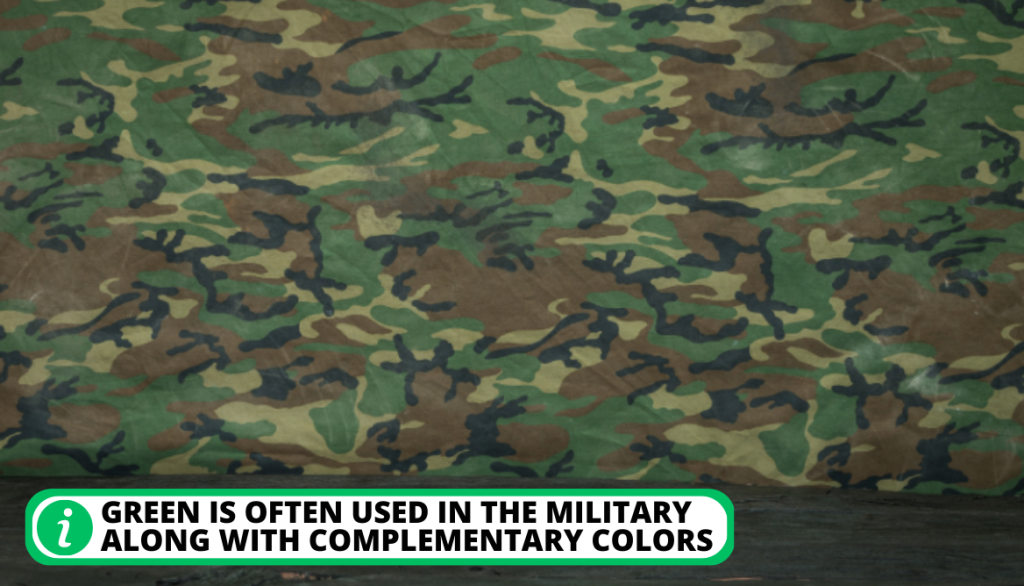
We have shown the basic properties of Army green in the color palette in the table below such as the Hex color code, RGB values, color composition, CMYK values, etc.
Color Name: | Army Green |
Others Names: | Dark green/Bottle green; Hunter green/Military green; Brunswick green/Grass green |
Hex Color Code: | #4B5320 |
Color Composition: | 12.5% of blue; 29.4% of red; 32.5% of green |
CMYK Values: | 9.6%; 0.0%; 61.4%; 67.5% |
Similar Colors: | Dark olive green; Avocado dark green; Gardener green; Basil green |
RGB Color Code: | RGB (75, 83, 32) |
What shade is the Army Green?
Army Green color is predominantly a member of the green family in the color palette. It resembles the color of the grass or leaves blending with the background color of the forest.
Army green is mostly used in various military uniforms to create camouflage patterns because of its importance in nature. So, What shade of green is army green color?
- The shade of Army green is created by a mix of brown yellow and green pigments.
- Army green is a flexible tint that pairs well with a neutral color like off-white, white, beige, cream, tan, black, etc.
- Bottle green is a typical color that is frequently used in web, graphics, and product design.
- Viewers find Grass green relaxing to the eyes and helps them focus on what the speaker is trying to say.
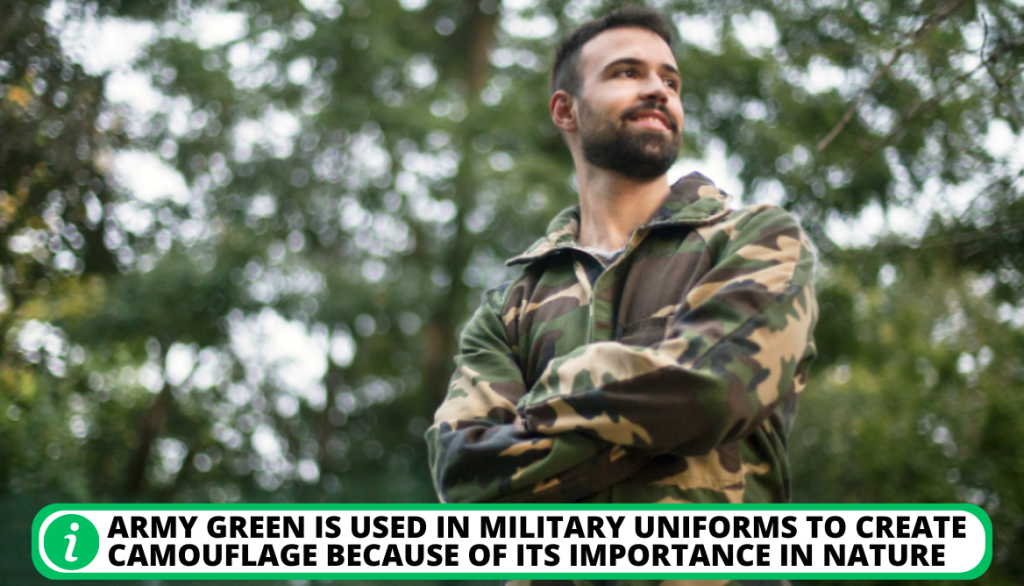
Is Army Green Cool or Warm?
Army green is unquestionably a mellow color that creates an amazing look, despite the fact that there are chilly shades of green that match and may appear to be Army green.
- Mellow greens are with a grass-like tinge of dark shade yellow also called drab.
- Mellow greens are also available in specific shades of khaki green, olive green, fern green, Kelly green, chartreuse, and moss, which are frequently used to describe clothing.
- The Army green color used in military uniforms is typically mixed with various mellow and chilly greens to create camouflage patterns such as olive drab and olive green.
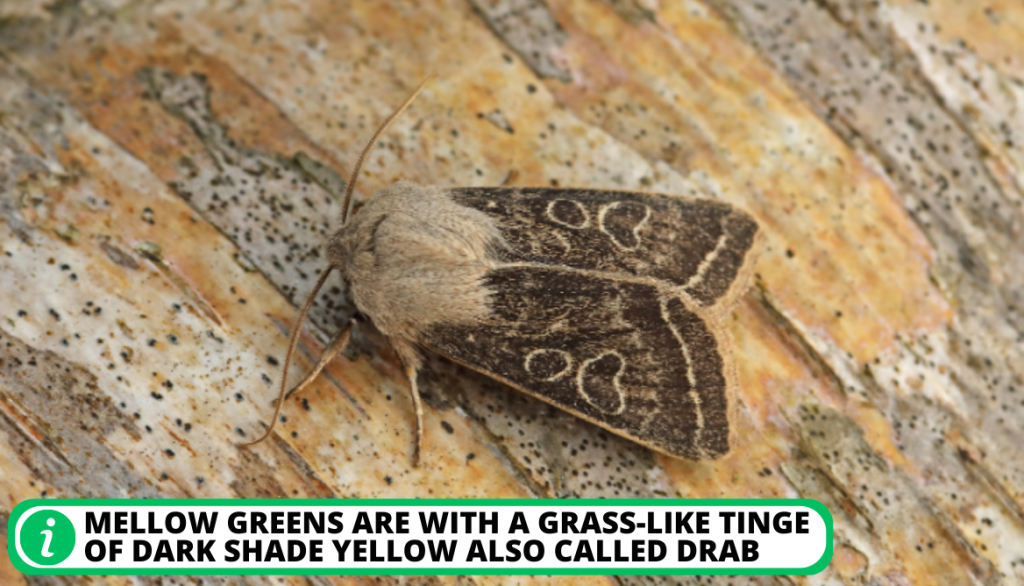
What is Army Green’s LRV?
LRV is a color property that is very important when working with colors. The Light Reflectance Value (LRV) of color describes how light or dark it will appear.
- Army Green has almost 8 LRVs.
- It is a dark color based on LRV value using a scale from 0 (black) to 100 (white).
- The color Army green is 69° (degrees) in tint, 44% saturation, and 23% lightness.
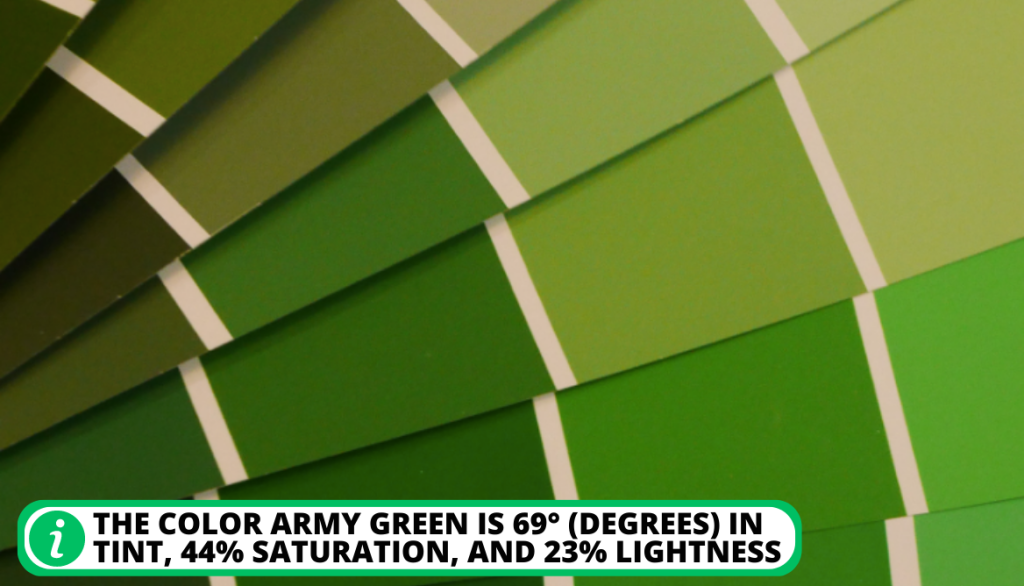
The Hexadecimal Color Code of Army Green
Hexadecimal color codes often shorten hex color codes starting with a hashtag are made up of a 6-symbol code comprising three 2-symbol elements used to describe a color. Each of the elements’ two symbols in the hex codes represents a color value between 0 and 255.
- Hex color code includes both numbers and alphabets to describe a color code.
- The Hex technique used to create the code converts each value into a distinct 2-digit alphanumeric code.
- The Army green hex color code is #4b5320 and widely used by the military since world war 2.
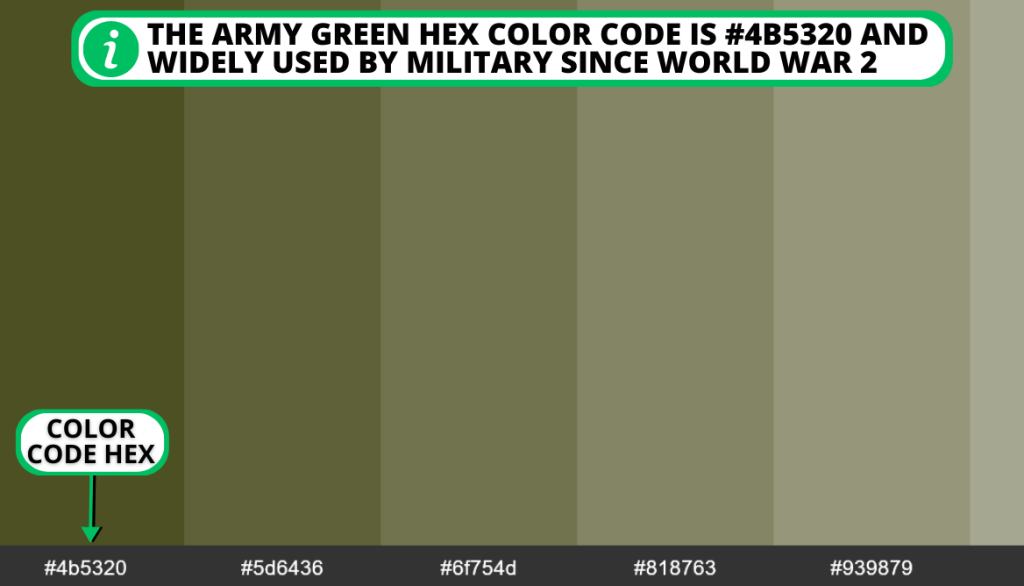
The RGB Values and Percentages for Army Green
The RGB represents the proportions of the three main colors that together made up one color. This RGB color value has the generic syntax, where color is specified as a triplet of either percentages or integers.
The RGB values of Army green color with hex code #4b5320 are 12.5% comprised of blue; 29.4% of red; 32.5% of green with the integers 75 for red, 83 for green, and 32 for red.
- The integers can be in the range of 0 to 255 and the percentage values of RGB can be in the range of 0% to 100%.
- The RGB colors are the same for all shades of green color but there are variations in values.
- The RGB element also applies to other colors too.
- Although Army green color and other shades of green also contain both secondary and tertiary colors like yellow, yellow green, and brown but there are variations etc.
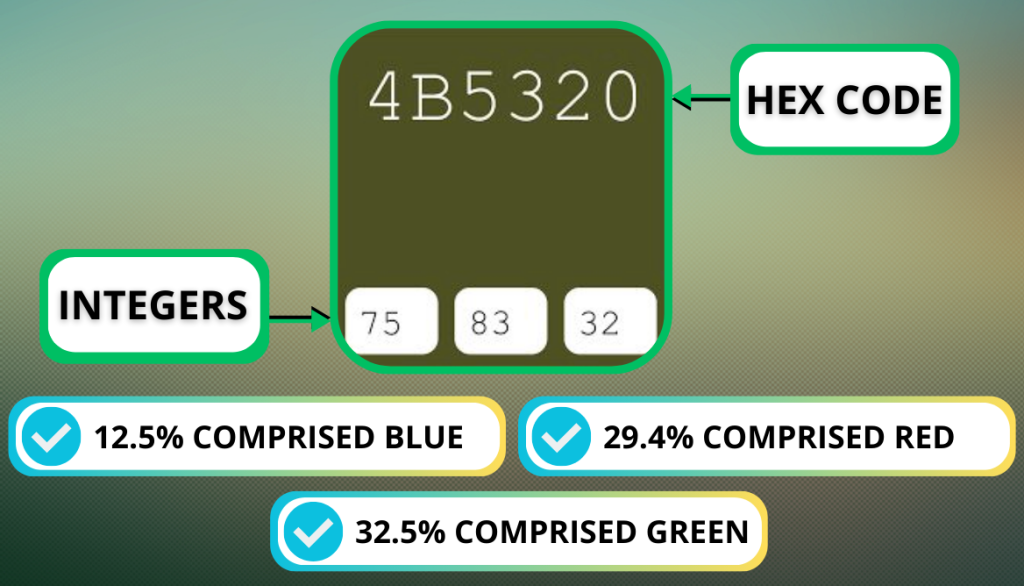
The CMYK Values for Army Green color
The CMYK values concentrate on 4-color combinations, unlike the RGB values. The letters CMYK stand for Cyan, Magenta, Yellow, and black; these CMYK are the printing-related colors.
To avoid being confused with blue, the letter “K” in the term CMYK stands for “Key,” which actually means “black.”
- The majority of printer types use this four-color technique of CMYK to print images that are placed on top of one another to produce various shades and gradations.
- The CMYK values for army green color with the hex code #4b5320 are 9.6% cyan, 0% magenta, 61.4% yellow, and 67.5% black.
- The Pantone matching system also works with CMYK mode because it aids in displaying printed materials with true color.
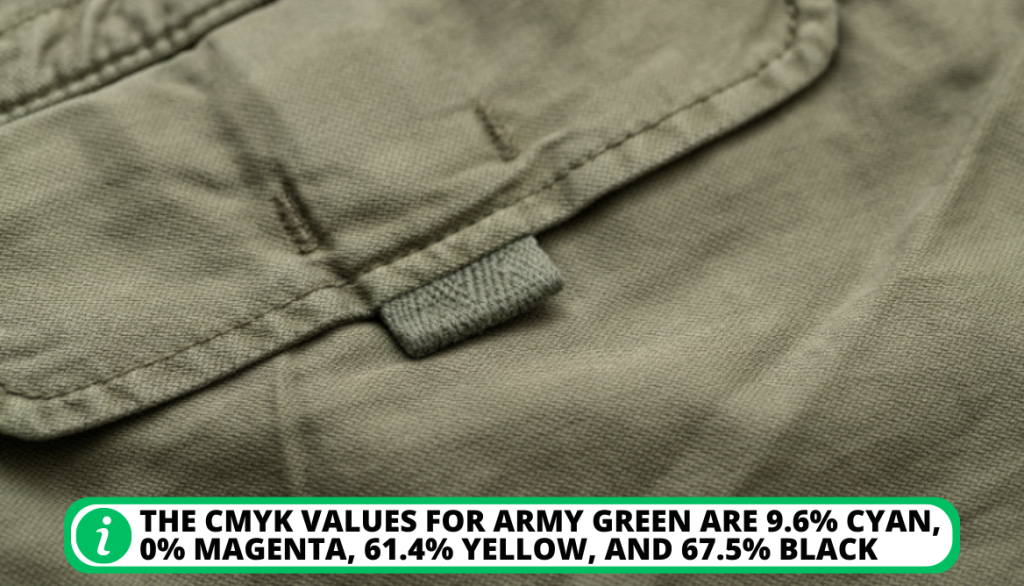
The Main Difference Between RGB and CYMK Values
CMYK mode is meant for printing purposes while the RGB is meant for screen display. If you apply more color to your design then the CMYK mode appears darker while the RGB appears lighter.
Hue, saturation, and brightness or Value are abbreviated as HSB or HSV which explains colors in terms of tint, amount of gray, and brightness.. It is a color-picking mechanism.
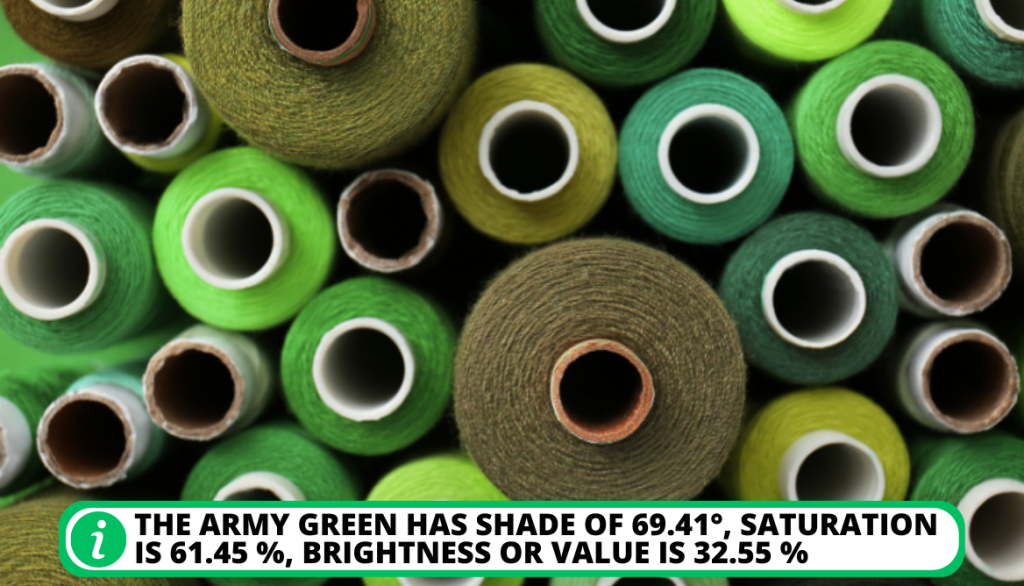
Our Final Take on Army Green
Army green is a beautiful color with a multipurpose tint that complements most skin tones beautifully when worn with a neutral color. Army green looks excellent on walls, and furniture, and is one of the most popular colors used in digitals with other complementary colors.
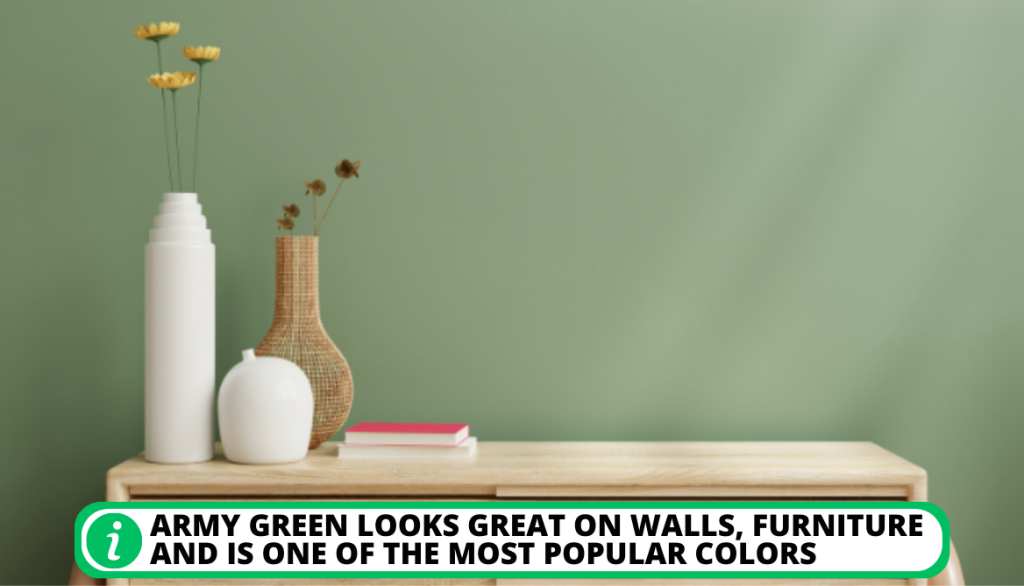
Although other shades and army green are frequently confused in the color palette they all have different hex and CMYK values.
Important: Even though forest green is often referred to as army green. Forest green is slightly different and is used in graphic design with the hex color code #228B22.
FAQ
What is the shade of army green color?
The army green color is a shade of dark yellow and green.
What is army green called?
The Army green is called the Military color.
What color is the army?
The army color is Dark green.
Is dark green a shade of green?
Yes, Dark green is a shade of green color.
What is the opposite of army green?
The opposite of Army green is a Manatee of the purple shade.
Conclusion
It has long been debatable what shade of green is army green. Dark green with code #4b5320 is the best response to this query. The army green color, often known as military green, is suitable for graphic design and painting on both the inside and outside of buildings.
Off-white, black, red, yellow, tan, and brown are appropriate complements. When looking for a temperate color, army green is a good choice that should be taken into consideration.
What color would you pair with Army green color? Please leave your response in the comments section below. Thanks for reading.
- How to Get Potatoes to Sprout Eyes: Detailed Growing Guide with 3 Options - July 31, 2023
- Weight of a Medium Potato: Revealed in Detailed Guide - July 29, 2023
- Maris Piper Potatoes: 9 Substitutes You Should Know About - July 27, 2023
Hello! I’m Jessica Zander, a garden coach and consultant based in the Boston area (zone 6b), offering virtual consultations across the country and Canada.
I’ve been passionate about gardening since the early 1990s, and in 2022, I launched You Can Do It Gardening to empower individuals to feel more confident in their gardening endeavors.
Following a 30-year career in nonprofit finance and operations, I transitioned out of that field in mid-June of 2023 due to the growing demand for coaching services. Interestingly, my years of presenting financial statements to boards and finance committees proved to be valuable experience for teaching people about gardening! I enjoy sharing skills, providing guidance and suggestions, and collaborating efficiently with clients to make significant improvements to their outdoor spaces, both small and large. I also regularly teach at the Arlington Continuing Education and Cambridge Adult Education.
My approach is direct and practical, akin to Mary Poppins, but tailored to your garden. Clients find satisfaction in saving money and taking pride in their own gardening achievements.


Add comment